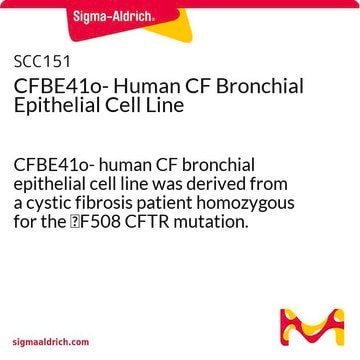Recommended Products
biological source
human lung
description
Human bronchial epithelium, normal
form
liquid
growth mode
Adherent
karyotype
Not specified
morphology
Epithelial-like
products
Not specified
receptors
Not specified
technique(s)
cell culture | mammalian: suitable
shipped in
dry ice
storage temp.
−196°C
Cell Line Origin
Human bronchial epithelium, normal
Cell Line Description
BEAS-2B cells were derived from normal bronchial epithelium obtained from autopsy of non-cancerous individuals. Cells were infected with a replication-defective SV40/adenovirus 12 hybrid and cloned. Squamous differentiation can be observed in response to serum. This ability can be used for screening chemical and biological agents inducing or affecting differentiation and/or carcinogenesis. The cell line has been applied for studies of pneumococcal infection mechanisms. BEAS-2B was described to express keratins and SV40 T antigen. Subculturing the cells before confluency is necessary as confluent cultures rapidly undergo squamous terminal differentiation.
Application
BEAS-2B Cell line has been used to study differentiation of squamous cells and effect of biological and chemical agents on differentiation.
DNA Profile
STR-PCR Data: Amelogenin: X,Y
CSF1PO: 9,12
D13S317: 13
D16S539: 12
D5S818: 12,13
D7S820: 10,13
THO1: 7,9.3
TPOX: 6,11
vWA: 17,18
CSF1PO: 9,12
D13S317: 13
D16S539: 12
D5S818: 12,13
D7S820: 10,13
THO1: 7,9.3
TPOX: 6,11
vWA: 17,18
Culture Medium
BEGM, also known as LHC-9 with modification (available from Clonetics Corporation, CC3171 (BEBM) plus additives CC4175 or BEGM Bullet Kit, CC3170); Note: Additives supplied contain gentamycin which has been omitted for culture at ECACC; media is serum-free.
Subculture Routine
Passage sub-confluent cultures using 0.25% trypsin or trypsin/EDTA. Incubate at room temperature for 5-10 min until cells detach. Add fresh medium and disperse cells, centrifuge and resuspend pellet in medium. Seed into new flasks at 1500 to 3000 cells per cm2. Flasks have to be precoated with a mixture of 0.01 mg/ml fibronectin, 0.03 mg/ml collagen and 0.001 mg/ml bovine serum albumin dissolved in BEGM. Add mixture at ratio of 0.2 ml per cm2 surface area. Incubate at 5% CO2, 37°C for at least 6 hours at 37oC. Remove excess fluid and allow flasks to dry by incubating at 37oC overnight, leaving the caps loose. Prior to addition of cells wash flask three times with PBS. Note: BEGM medium is almost serum-free, therefore trypsin inhibitor is essential. Add an equal or greater volume of trypsin inhibitor as trypsin used before, centrifuge and reseed cells in collagen coated flasks using culture medium.
Other Notes
Additional freight & handling charges may be applicable for Asia-Pacific shipments. Please check with your local Customer Service representative for more information.
Cultures from HPA Culture Collections and supplied by Sigma are for research purposes only. Enquiries regarding the commercial use of a cell line are referred to the depositor of the cell line. Some cell lines have additional special release conditions such as the requirement for a material transfer agreement to be completed by the potential recipient prior to the supply of the cell line.
Please view the Terms & Conditions of Supply for more information.
Cultures from HPA Culture Collections and supplied by Sigma are for research purposes only. Enquiries regarding the commercial use of a cell line are referred to the depositor of the cell line. Some cell lines have additional special release conditions such as the requirement for a material transfer agreement to be completed by the potential recipient prior to the supply of the cell line.
Please view the Terms & Conditions of Supply for more information.
Disclaimer
RESEARCH USE ONLY. This product is regulated in France when intended to be used for scientific purposes, including for import and export activities (Article L 1211-1 paragraph 2 of the Public Health Code). The purchaser (i.e. enduser) is required to obtain an import authorization from the France Ministry of Research referred in the Article L1245-5-1 II. of Public Health Code. By ordering this product, you are confirming that you have obtained the proper import authorization.
Storage Class
10 - Combustible liquids
wgk_germany
WGK 3
flash_point_f
Not applicable
flash_point_c
Not applicable
Certificates of Analysis (COA)
Search for Certificates of Analysis (COA) by entering the products Lot/Batch Number. Lot and Batch Numbers can be found on a product’s label following the words ‘Lot’ or ‘Batch’.
Already Own This Product?
Find documentation for the products that you have recently purchased in the Document Library.
J E Adamou et al.
Infection and immunity, 66(2), 820-822 (1998-02-07)
Pneumococcal adherence to alveolar epithelial cells and nasopharyngeal epithelial cells has been well characterized. However, the interaction of Streptococcus pneumoniae with bronchial epithelial cells has not been studied. We have now shown that pneumococci bind specifically to a human bronchial
Yu-Jung Lin et al.
Heliyon, 9(9), e20011-e20011 (2023-10-09)
Severe acute respiratory syndrome coronavirus 2 (SARS-CoV-2) has caused 403 million cases of coronavirus disease (COVID-19) and resulted in more than 5.7 million deaths worldwide. Extensive research has identified several potential drug treatments for COVID-19. However, the development of new
Björn Klabunde et al.
Nature communications, 14(1), 5818-5818 (2023-10-03)
Lower respiratory tract infections caused by Streptococcus pneumoniae (Spn) are a leading cause of death globally. Here we investigate the bronchial epithelial cellular response to Spn infection on a transcriptomic, proteomic and metabolic level. We found the NAD+ salvage pathway
An antagonist of the platelet-activating factor receptor inhibits adherence of both nontypeable Haemophilus influenzae and Streptococcus pneumoniae to cultured human bronchial epithelial cells exposed to cigarette smoke
Shakti D Shukla
International Journal of Chronic Obstructive Pulmonary Disease, 11 (2016)
R Garcia-Villar et al.
British journal of pharmacology, 118(5), 1253-1261 (1996-07-01)
1. This study tested the hypothesis that a nitric oxide synthase (NOS) was activated in guinea-pig ileum in vitro in response to substance P (SP), and attempted to characterize the tachykinin receptor involved in this activation by the use of
Our team of scientists has experience in all areas of research including Life Science, Material Science, Chemical Synthesis, Chromatography, Analytical and many others.
Contact Technical Service






